India's Leopard God, Waghoba, Aids Wildlife Conservation In The Country
Categories: Animals | Asia | People | Photo project | World
By Vika https://pictolic.com/article/indias-leopard-god-waghoba-aids-wildlife-conservation-in-the-country.html"People in other cities have cats and dogs, but here we have wild leopards as our companions. Leopards are family to us. We also pray to the Waghoba- our leopard deity, who keeps us safe from all evils." - Prakash Bhoir, a resident of Mumbai.
Indeed, the bustling metropolis of Mumbai, India's financial capital, is a city like no other. While it houses a human population of more than 20 million, it also has a heart spacious enough to accommodate over 40 wild leopards! Mumbai also has temples where indigenous communities or Adivasis worship these big cats in the form of the Waghoba. And according to science, this cultural reverence for the predators, allows people to share space with the wild animals, facilitating conservation in the long run. Thus, understanding such cultural institutions is essential for the implementation of modern conservation practices.
10 PHOTOS
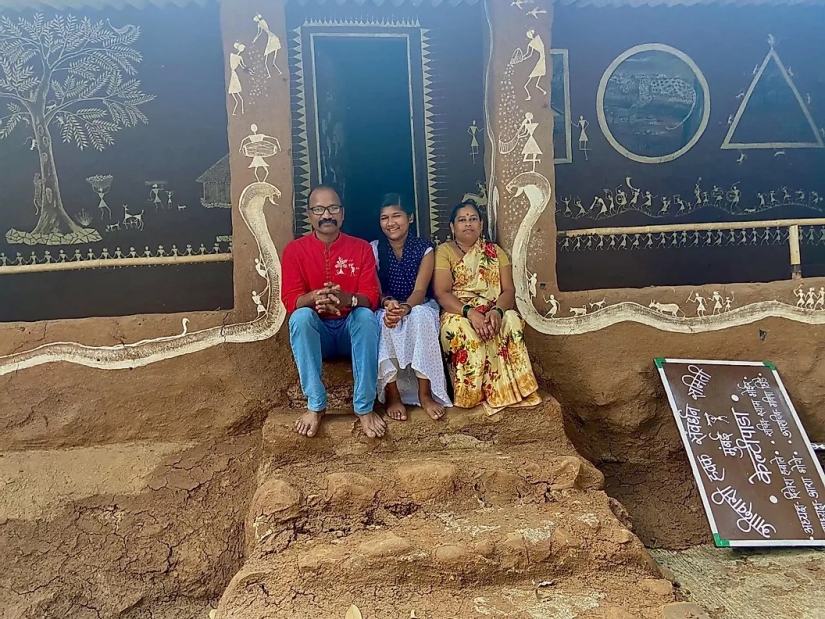
1. Mumbai's Forest Gods And Forest People
The Bhoir family is in front of their mud home with Warli paintings on the walls. Warli painting is a tribal art form focussing on the elements of nature. Image credit: Mahesh Yadav/JY Brothers
"We, the Adivasis of Mumbai, worship Hirwa Dev or Green God who blesses our lives with natural resources that keep us alive. We also pray to the Waghoba or the leopard/tiger God. He is the King of the Forest. The strength and courage of the Waghoba keep our forests safe. And we all know that forests are necessary for our survival," said Chaitali Bhoir, a young woman and a member of the Adivasi community, as she showed us around her beautiful mud home in Kelti pada in the heart of the forested Aarey Milk Colony.

2. Waghoba painted on a stone slab and decorated with a marigold flower garland in a tribal temple in Mumbai's Aarey Colony. Both tigers and leopards are worshipped as Waghoba. Image credit: Oishimaya Sen Nag
The Adivasis of Mumbai are indigenous communities belonging to various tribes like Warlis, Kolis, Dubbas, and others. They have a deep-rooted connection with nature. In Mumbai, they live in tiny hamlets called padas, primarily in and around the forested patches like the Sanjay Gandhi National Park and adjacent Aarey Milk Colony. Leopards roam wild in such places, but these people hardly complain. On the contrary, they take pride in living with the predators.
"We respect the wild animals and their way of life. We know that once the night falls, we must stay indoors and not venture out alone. It is time for the leopards to roam around. Sometimes, they do prey on our livestock. So, whenever a leopard roars near us, we break a coconut shell praying to the Waghoba to spare our livestock but continue to protect our forest and our lives as he has done for millennia," said Prakash Bhoir, Chaitali's father-in-law. Prakash, an Adivasi, also holds a job in the local municipal corporation.
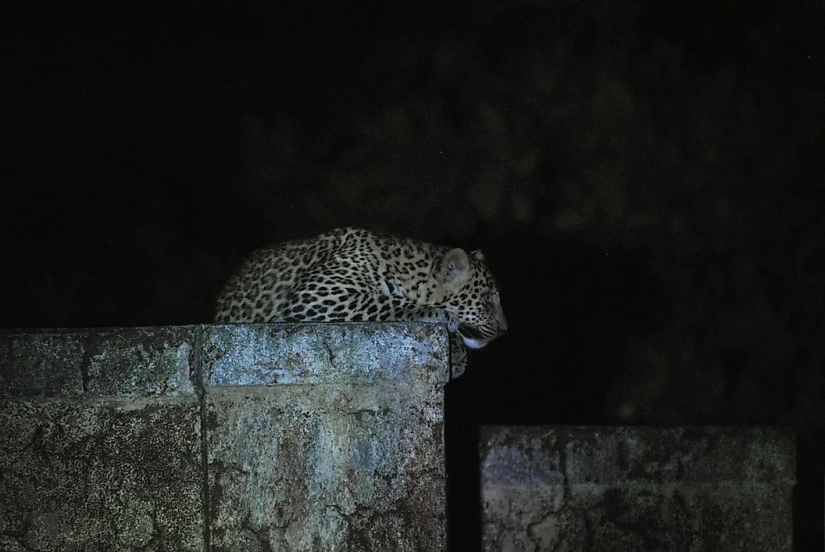
3. A leopard resting on a ledge at night in Aarey Milk Colony of Mumbai. Image credit: Mahesh Yadav/JY Brothers
According to him, most leopard attacks on humans in Mumbai occur when people disrespect the forest rules. As immigrants from elsewhere encroach into forested land, they do not pay heed to the ways of nature. They cut down trees, dump garbage irresponsibly, and change the landscape in ways that derail the smooth functioning of the ecosystem. With reduced space and natural prey, leopards now get attracted to dogs and pigs feeding on garbage, bringing them in close contact with humans. Sometimes, these predators end up attacking humans, leading to the public demand to remove the leopards from the area.
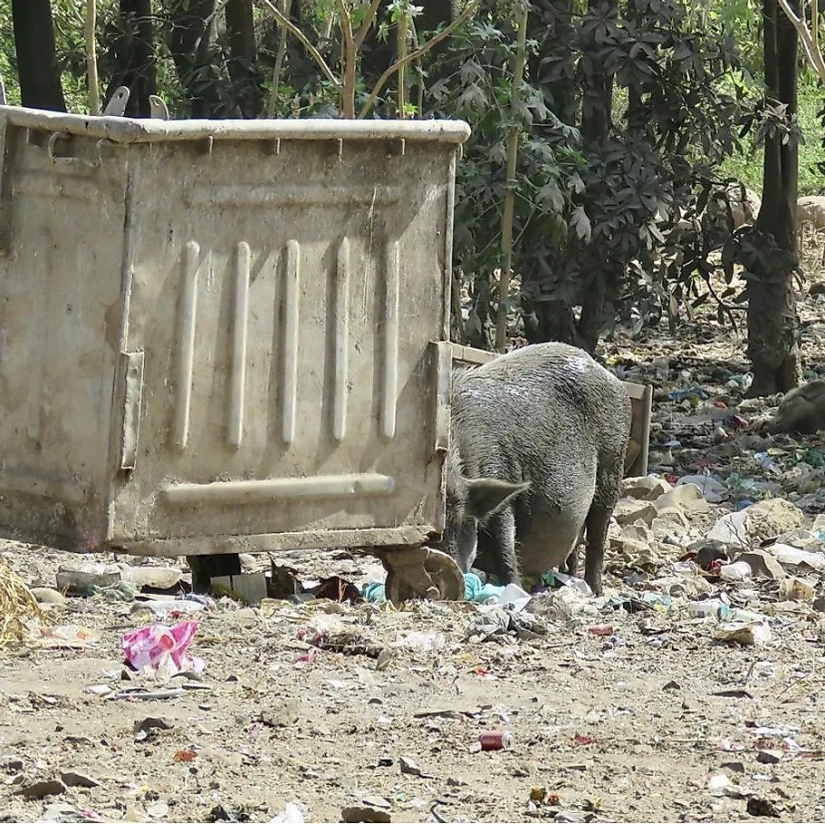
4. Pigs feeding on garbage dumped irresponsibly along the fringes of Sanjay Gandhi National Park in Mumbai. Image credit: Oishimaya Sen Nag
"Unlike our non-adivasi neighbors, we welcome the leopard. We keep our surroundings clean and garbage-free so that when the leopard visits us, he stays for a while and then leaves. A couple of months back, a leopard visited my backyard a day before my son's wedding. He just stood there for a few minutes and then left silently. I told my wife that here is the Waghoba to bless us before the event!" said Bhoir pointing to where the leopard stood just a few yards from his house.
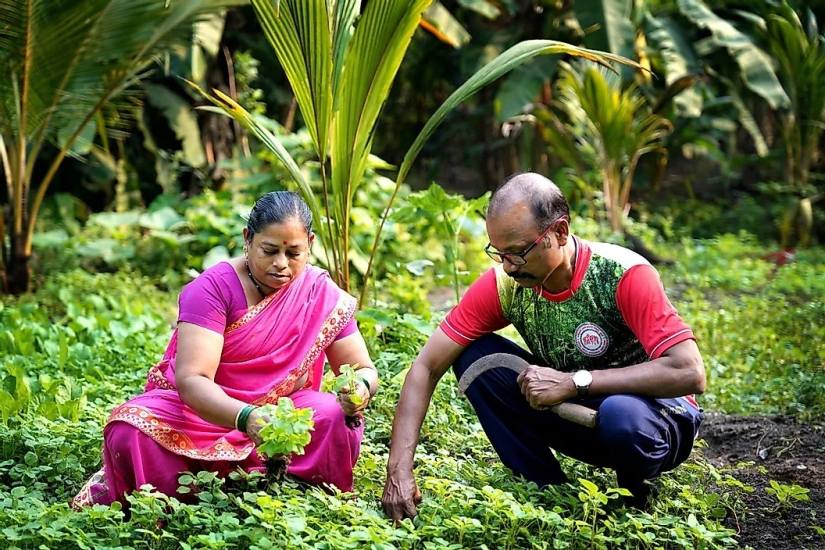
5. The Bhoirs grow their own vegetables in a vegetable garden outside their home, plant native trees, and keep their surroundings clean and green, leading a sustainable lifestyle. Image credit: Mahesh Yadav/JY Brothers
Bhoir also finds it unfortunate that news channels often portray stories of leopards entering human homes when, in reality, humans have invaded leopard territory. He worries that people's fear of leopards might spell doom on the forest. To him, leopards are beautiful animals and not the fierce, bloodthirsty beasts that people often think them to be. Nature has designed them to be carnivores, so they need to hunt for their survival. That cannot make them dangerous. If that is so, humans are dangerous too. For Bhoir and his other community members, however, leopards are family.
"Our attachment with this beautiful animal is such that if we do not see or hear about leopard sightings in our area for about a week, we get concerned. We worry that someone might have killed them or caused any other harm to them," said Bhoir.
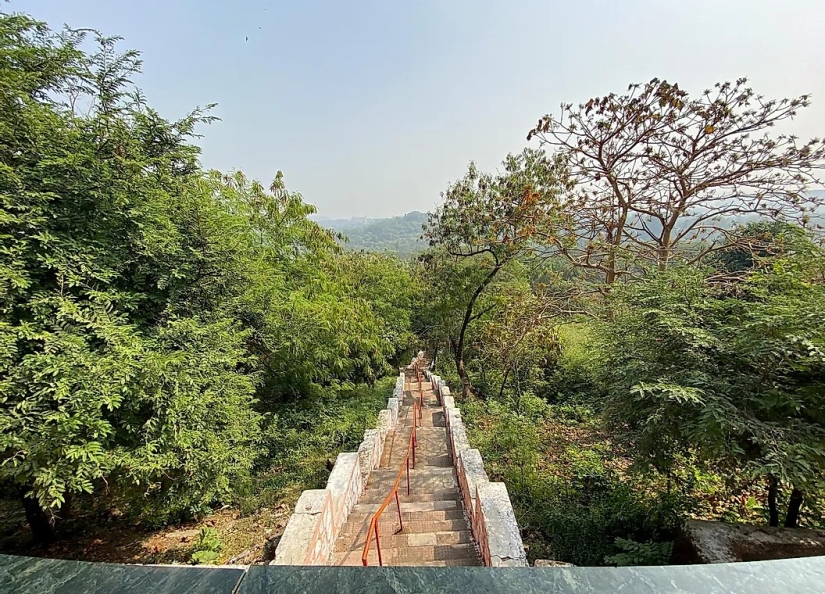
6. The forested Aarey Milk Colony in Goregaon, Mumbai.
This deep bonding with the forest and its leopards keeps Bhoir and his tribal community members alert. Whenever there is a threat to the forests of Mumbai, the Adivasis rise up in protest. During the Save Aarey Movement, many of them were arrested by the police while protesting against the felling of trees in Aarey to construct a metro carshed facility. Their protests, however, did not go in vain. The project had to be shifted to a new location, and a part of Aarey was declared a reserve forest.
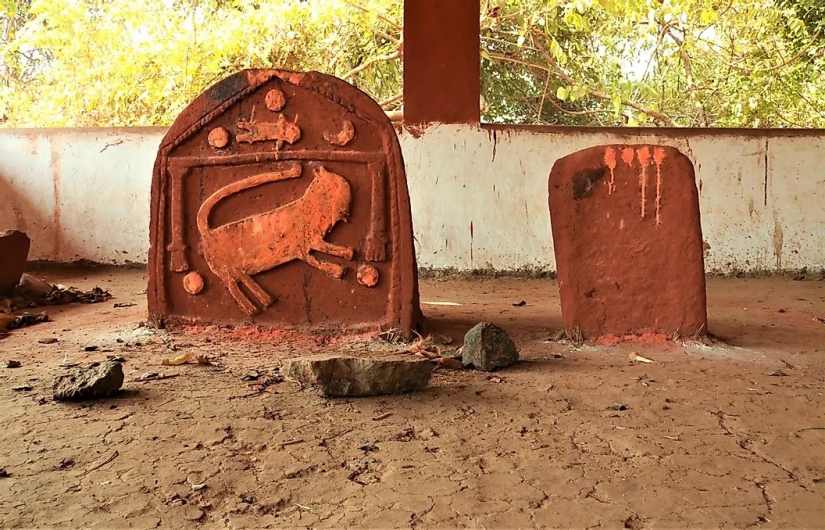
7. Conservation Science And People's Beliefs - The Connection
Waghoba Shrine at Varwade in Talasari, Maharashtra. Image Credits: Project Waghoba/Ramya Nair
The worship of the Waghoba and other elements of nature is not limited to the Adivasis of Mumbai but is more widespread. A study published in Frontiers in Conservation Science in 2021 documented over 150 shrines dedicated to the Waghoba in villages of the Warli tribals in Mumbai and other parts of the state of Maharashtra. The study was conducted by researchers from WCS-India, WCT-India, INN Univ., Norway, and NINA, Norway.
The study discovered that the origin of the institution of the Waghoba is rooted in what today's modern conservation science terms as "human-wildlife conflict" and "livestock depredation by big cats." Although the origin story has many variants, most depict Waghoba as someone born human. With time, the Waghoba exhibited traits of the "wagh or tiger/leopard" and killed village livestock. The frightened villagers wanted to kill Waghoba but his mother negotiated a deal with them. According to the agreement, the Waghoba would stay in the forest and not kill livestock. In exchange, the people would worship the Waghoba in Waghoba shrines and make occasional offerings to him in the form of animal sacrifices to appease him. Thus, according to the researchers, the Waghoba's origin story itself instills a feeling of kinship with the big cats in the hearts of the Waghoba worshippers. The institution of the Waghoba acts as a tolerance-building mechanism allowing people to share space with apex predators like tigers and leopards.
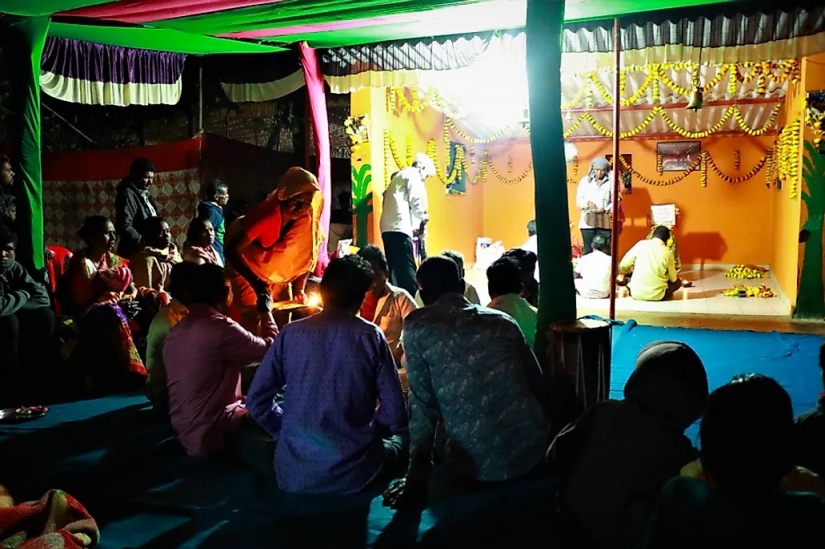
8. A Waghoba worship ceremony. Image credit: Ramya Nair
"India has been practicing conservation through its culture for thousands of years. Cultural institutions like Waghoba worship have served as the driving force behind the deep-rooted conservation movement prevalent in the country," said Dr. Anish Andheria, who co-authored the study. He is also the President of Wildlife Conservation Trust, India, and one of India's leading wildlife conservationists.
"Ancient Indian scriptures depict animals as Gods. Animals ranging from elephants and tigers to ants and rats are worshipped in the country. Such reverence for animals acts as a catalyst in safeguarding our ecosystems and wildlife," he said.
According to Dr. Andheria, it is more important now than ever before to recognize people's cultural affiliations before they disappear in an era of consumerism and globalization, snapping their connection with nature. The bond between people and nature needs to be rejuvenated and preserved before it is lost. He also believes that the engagement of local communities is vital to further conservation goals in India.

9. Aarey leopard. Image credit: Ranjeet Jadhav/AareyGP
"In the last five decades, conservation in India has mostly focused on protecting forested landscapes from people. However, only around 5% of the country's area could be protected that way. That is not enough. Protection now needs to be community-managed. Conservation conversations should include the local communities and their opinions integrated while designing conservation programs," he said.
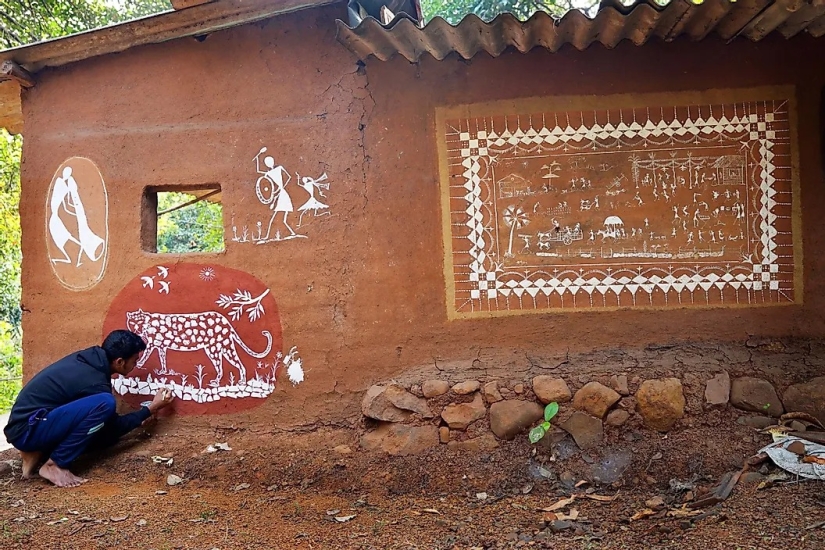
10. Holding On To Nature Worship
Today, India's socio-economic scene is changing at a fast pace. Rapid urbanization is taking place all over the country. The integration of indigenous communities like Mumbai's Adivasis into mainstream society is diluting their cultures based on nature worship. But people like the Bhoirs are determined to hold on to their traditions and beliefs.
Leopards play a major role in the life of the Aadivasis of Mumbai. Here, a Warli painter is painting a leopard on the facade of a home in Aarey Milk Colony. Image credit: Mahesh Yadav/JY Brothers
"People call Adivasis poor and illiterate. But our homes are surrounded by thousands of trees and rich biodiversity. How can we be poor when we have so much natural wealth? We are also proud of the knowledge inherited from our ancestors. We are aware that the forest keeps us alive. It gives us oxygen, food, and more. And hence we worship water, soil, forest, and wildlife. We are proud of our beliefs as they help protect and preserve natural resources for our future generations," said Prakash Bhoir.
"We are like guests on this Earth. We must say thank you to Mother Earth for our life. So, do not cause any harm to her. No other species does so," is Bhoir's message to all of us.
Keywords: India | Leopard God | Waghoba | Wildlife | Wildlife Conservation | Aids | Leopards
Post News ArticleRecent articles

Most of us think that the color of the eggshell does not play any role and it is possible not to pay attention. But it's not and ...

The more we rely on technology, the more potential power hackers gain over us. It doesn't matter if their goal is to help or cause ...
Related articles

It's amazing, but there are still places on our planet where holiness is not an empty phrase, and in order to achieve it, people ...

Do you think that a studio apartment can't be a tropical garden? The designers of one of the Indian architectural studios have ...

A 20-year-old Indian, Sushant Sushil Rane, draws absolutely ordinary things on paper: light bulbs, telephones, beverage cans, ...

Creating a good portrait is one of the most difficult tasks for any photographer. In order to make a really natural and memorable ...